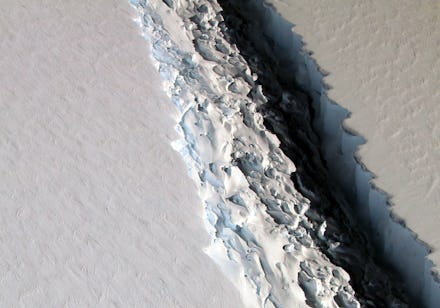An ice shelf the size of Delaware is about to break from Antarctica

A giant chunk of ice the size of Delaware is threatening to cleave itself from one of the largest ice shelves in Antarctica, and its imminent collapse could further threaten the landscape of the region.
On July 5, researchers at the European Space Agency’s CryoSat mission announced in a report that a large crack running along the Larsen C ice shelf now measures 200 km, leaving just five kilometers — or three miles — between in the bottom of the crack and the ocean.
The iceberg that could result from the break would be around 2,300 square miles in size, which, as CNN reports, is roughly seven times the size of New York City.
Jonathan Kingslake, an assistant professor at the Lamont-Doherty Earth Observatory, said in a statement provided to Mic that while there’s no definitive connection between human activity and the collapse of the Larsen C ice shelf, warming on the Antarctic Peninsula in general is broadly linked to man-made climate change.
According to Kingslake, collapsing ice shelves present a whole host of complicated problems within the region — including allowing land ice to flow faster, which in turn causes rising sea levels.
“Predictions of sea-level rise are uncertain — the ice, atmosphere and oceans interact in complex ways that we don’t fully understand — but the main point is that sea-level is rising and will very likely continue to rise as glaciers and ice sheets shrink in response to climate warming,” he said. “We need to understand this better.”
While the splintering of Larsen C has accelerated in recent weeks, it’s been on scientists’ radar for years. In a June 28 report, the U.K.-based Project Midas reported that between June 24 and June 27, the “soon-to-be-iceberg” portion of the shelf had tripled the speed at which it was splitting from the rest of Antarctica, reaching more than ten meters per day.
“The iceberg remains attached to the ice shelf, but its outer end is moving at the highest speed ever recorded on this ice shelf,” the authors of the report wrote at the time. “We still can’t tell when calving will occur — it could be hours, days or weeks — but this is a notable departure from previous observations.”
As man-made global warming continues to threaten Antarctica’s disintegrating ice shelves, Mark Drinkwater, head of the mission science division at ESA’s European Space Research and Technology Centre, said that Larsen C’s breakage will be of particular significance because of its massive size.
“This is a single piece which is remarkable I guess because it’s of somewhat biblical proportions,” Drinkwater said in an interview with Mashable.
If the Larsen C shelf splits, it won’t just become one of the most massive icebergs in recorded history — NASA scientists say the deeper ice it leaves exposed in its wake will only become more vulnerable once it’s exposed to the climate in one of the fastest-warming areas on Earth.
Scientists are also concerned about what a break could mean for the future stability of an ice shelf that has already undergone dramatic disruption in recent decades: Larsen A and Larsen B are already gone, having collapsed into the sea in 1995 and 2002, respectively.